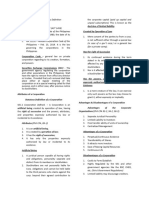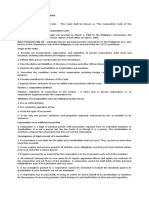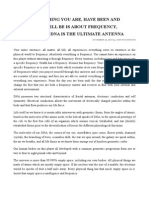Sec. 2. Corporation Defined. - A Corporation Is An Artificial Being Created by
Uploaded by
Rose Jean Raniel OropaSec. 2. Corporation Defined. - A Corporation Is An Artificial Being Created by
Uploaded by
Rose Jean Raniel Oropa1. Give the statutory definition of a corporation. Sec. 2. Corporation defined.
A corporation is an artificial being created by operation of law, having the right of succession and the powers, attributes and properties expressly authorized by law or incident to its existence. 2. What are the attribute of a corporation? Attributes of a corporation: a. It is an artificial being- it has a personality separate and distinct from the stockholders or members and which commences upon the issuance of its certificate of incorporation. b. It is created by operation of law- persons desiring to form a corporation must comply with the requirements of the law governing its creation. c. It has the right of succession its existence is not affected yb the death, insolvency, or incapacity of the individual stockholders or members. d. It has the powers, attributes and properties expressly authorized by law or incident to its existence 3. Explain the doctrine of piercing the veil of corporate entity. Piercing The Veil Of Corporate Entity The courts have pierced the veil of corporate entity, considering the corporation merely as an association of persons, or where there are two corporations , they will be considered as one, the one being merely regarded as part or the instrumentality. 4. What are the similarities between partnerships and corporations? Similarities between partnerships and corporations: a. Both have separate juridical personality b. Both are artificial persons, i.e. they have no bodily existence, and can only act through agents. c. Both are composed of a group of persons with the exception of corporation sole d. Like a partnership, a corporation distributes its profits to those who contribute capital (although an industrial partner also shares in partnership profits ); e. Like a partnership, a corporation can be organized only where there is la authorizing its organization; f. A partnership, no matter how created or organized is taxable as a corporation, subject to income tax. 5. Enumerate: Advantages of business corporation and Disadvantages of business corporation. Advantages of Business Corporation: a. Has a legal capacity to act as a legal unit b. Has a continuity of existence because of its nondependence on the lives of those who compose it c. Its credit is strengthened by such continuity of existence d. Its management is centralized in the board of directors e. Its creation, organization, management and dissolution are standardized as they are governed under one general incorporation law f. It makes feasible gigantic financial enterprises since it enables many individuals to invest their separate funds in the enterprise g. The shareholders have limited liability h. They are not general agents of the business and; i. The share of stocks can be transferred without the consent of the other stockholders
Disadvantages of Business Corporation: a. relatively complicated in formation and management b. it entails relatively high cost of formation and operation c. Its credit is weakened by the limited liability of the stockholders d. there is no ordinarily lack personal element in view of th transferability of shares e. there is a greater degree of governmental control and supervision than in any other forms of business organization f. the stockholders voting rights have become theoretical particularly in large corporations because of the use of proxies and widespread ownership g. the stockholders have little voice in the conduct of the business and; h. in large corporations, management and control are separate from ownership 6. What are the classifications of corporation? Classification of corporation under the code: a. stock corporation ordinary business corporation created and operated for the purpose of making a profit which may be distributed in the form of dividends to stockholders on the basis of their invested capital. b. non-stock corporation- do not issue stock and are created not for profit but for the public good and welfare. Other classifications of corporations a. As to no. of persons who compose them: 1. Corporation aggregate or corporation consisting of more than one member or corporator 2. Corporation sole or a religious corporation which consist of one member or corporator only and successor, such as a bishop b. As to whether they are for religious purpose or not: 1. Ecclesiastical corporation or one organized for religious purposes 2. Lay corporation or one organized for a purpose other than religion c. As to whether they are for charitable purposes or not: 1. Eleemosynary corporation or one established for charitable purposes 2. Civil corporation or one established for business or profit d. As to state or country under or by whose laws they have been created: 1. Domestic corporation or one incorporated under the laws of the Philippines 2. Foreign corporation or one formed, organized, or existing under any laws other those of the Philippines e. As to their legal right to corporate existence: 1. De jure corporation or a corporation existing in fact and in law 2. De facto corporation or a corporation existing in fact but not in law. f. As to whether they are open to public or not: 1. Close corporation or one which is limited to selected person or members of family 2. Open corporation or one which is open to any person who may wish to become a stockholder or member thereto g. As to their relation to another corporation: 1. Parent or holding corporation or one which is so related to another corporation that it has the power either, directly or indirectly, by such other corporation. 2. Subsidiary corporation or one which is so related to another corporation that the majority of its directors can be elected either, directly or indirectly, by such other corporation. h. As to whether they are corporation in a true sense or only in a limited sense: 1. True corporation or one which exists by statutory authority 2. Quasi corporation or one which exist without formal legislative grant. It is an exception on the general rule that a corporation can exist only by authority of law and it may be: A. Corporation by prescription or which has exercised corporate powers for an indefinite period without interference on the part of the sovereign power and which by fiction of law, is given the
status of corporation B. Corporation by estoppels or one which in reality is not a corporation i. As to whether they are for public or private purpose: 1. Public corporation or those formed or organized for the government of a portion of the state 2. Private corporation or those formed for some private purpose, benefit, or end; it may be either a stock or non-stock corporation, government owned or controlled corporation or quasi public corporation. 7. Distinguish between public and private corporation. Public corporation or those formed or organized for the government of a portion of the state while Private corporation or those formed for some private purpose, benefit, or end; it may be either a stock or non-stock corporation, government owned or controlled corporation or quasi public corporation. 8. What govern corporations created by special laws/charter? 9. Who are the four classes of persons composing a corporation? Four classes of persons composing a corporation: a. Corporators or those who compose the corporation, whether stockholders or members. Hence the term includes incorporarators, stockholders, or members. b. Incorporators or those corporators mentioned in the articles of incorporation as originally forming and composing the corporation and who executed and signed the articles of incorporation as such. c. Stockholders or the owners of shares of stock in stock corporation. They are the owners of the corporation. They are also called shareholders. d. Members or corporators of a corporation which has no capital stock. 10. Who are the following: a. Promoters or persons who bring about the or cause to bring about the formation and organization of a corporation by bringing together the incorporators or the persons interested in the enterprise, procuring subscriptions or capital for the corporation and setting in motion the machinery which leads to the incorporation of the corporation itself b. Subscribers or persons who have agreed to take and pay for original, unissued shares of a corporation formed or to be formed c. Underwriters or a person, usually an investment banker, who: a. has agreed, alone or with other , to buy at stated terms an entire issue of securities or a substantial part thereof; b. has guaranteed the sale of an issue by agreement to buy from issuing party and unsold portion at a stated price; or c. has agreed to use his best efforts to market all or part of an issue; or d. has offered for sale stock he has purchased from controlling stockholder. 11. Define : a. Capital stock is the amount fixed in the articles of incorporation, to be subscribed and paid in by the shareholders of a corporation, either in money or property, labor or services, at the organization of the corporation r afterwards and upon which it is to conduct its operation . it represent the equity of the stockholder in corporate assets. b. Authorized capital stock is synonymous with capital stock where the shares of the corporation have par value. c. Subscribed capital stock is the amount of the capital stock subscribed whether fully paid or not. d. Outstanding capital stock is the portion of the capital stock which is issued and held by persons other than the corporation itself. e. Paid capital stock is that portion of the subscribed or outstanding capital stock that is paid. f. Unissued capital stock is that portion of the capital stock that is not issued or subscribed. It does not vote and draws no dividends g. Legal capital stock is the amount equal to aggregate par value and/or issued
value of the outstanding capital stock 12. Distinguish between capital and capital stock. Capital and capital stock distinguished: a. Capital is the actual corporate property. It is, therefore, a concrete thing. Capital stock is an amount. It is, therefore, something abstract. b. Capital fluctuates or varies from day to day according as there are profits or losses or appreciation or depreciation of corporate assets. Capital stock is an amount fixed in the articles of incorporation and is unaffected by profits and losses. c. It is said that capital belong to the corporation and capital stock when issued belongs to the stockholders and that capital may be either real or personal property but capital stock is always personal. 13. What is a share of stock or stock? Share of stock or stock it is the integer unit of capital stock of a corporation representing the interest or the right which a stockholder has in the corporation. 14. Differentiate stocks from capital stock. As distinguished from capital stock, the term stock or share of stock is commonly used in distributive sense to refer to the stock in the hands of the stockholders. Therefore it belongs to them. On the other hand, the former is used in a collective sense to signify the whole body of shares of stock in the corporation. 15. What is a certificate of stock? Certificate of stock is a written acknowledgement by the corporation of interest, right and participation of a stockholder in the management, profit and assets of corporation. It is a formal written evidence of the holders ownership of one or more shares and is a convenient instrument for the transfer of title. 16. What are the classes of shares in general? a. Par value share is one with a specific money value fixed in the articles of incorporation and appearing in the certificate of stock for each share of stock of the same issue b. No par value is one without any stated or par value appearing on the face of the certificate of stock c. Voting share is share with right to vote. d. Non-voting share is share without right to vote. e. Common share of stock is stock which entitles the holder thereof to prorate division of the profits, if there are any, without any preference or advantage in that respect over other stockholder or class of stockholders f. Preferred share of stock is stock which entitles the holder thereof to certain preferences over the holders of common stock g. Promotion stock is such stock as is issued to promoters, or those in some ay interested in the company, or for services rendered in launching or promoting the welfare of the company , such as advancing the fees for incorporating, advertising, attorneys fees and etc h. Share in escrow is share subject to an agreement by virtue of which the share is deposited by the grantor or his agent with a third person to be kept by the depository until the performance of certain condition. i. Convertible stock is a stock which is convertible or changeable by the stockholders from one class to another class. 17. What are restriction regarding the issuance of no par value shares? Statutory restrictions regarding issuance of no par value: a. Banks, trust companies, insurance companies and building and loan
associations shall not be permitted to issue no par value shares of stock b. Preferred shares of stock may be issued only with a stated par value c. Shares issue without par value shall be deemed fully paid and non-assessable and the holder of such shares shall not be liable to the corporation or to its creditors in respect thereto. d. Shares without par value may not be issued for a consideration less than the value of P5.00 per share e. The entire consideration received by the corporation for its no par value shares shall be treated as capital and shall not be available for distribution as dividends. 18. What are the advantages and disadvantages of: Advantages of no par value shares: a. No par value shares are issued as fully paid and non assessable b. Their price is flexible c. Low-priced stocks enjoy wider distribution d. They tell no untruth concerning the value of the stockholders contribution e. Stock dividends are more easily issued thereby simplifying accounting procedure. Disadvantages of no par value shares: a. They legalize large issues of stock for property b. They conceal the money or property represented by the shares c. They promote issuance of watered stock and d. There is lesser protection to creditors. Advantages of par value shares: a. Par value shares are easily sold as the public is more attracted to buy this kind of shares. b. There is greater protection to creditors. c. There is unlikelihood of sale of subsequently issued shares at a lower price. d. There is unlikelihood of the distribution of dividends that are only ostensible profits. Disadvantages of par value shares: a. The subscribers are liable to corporate creditors for their unpaid and b. The stated face value of the value of the share is not an accurate criterion of its true value. 19. What are the kinds of preferred shares? Kinds of preferred shares: a. Preferred share as to assets is share which gives the holder thereof preference in the distribution of the assets of the corporation in case of liquidation. b. Preferred share as to dividends is share the holder of which is entitled to receive dividends on said share at fixed rates before any dividends at all are paid to common stockholders. 20. What are the kinds of preferred shares as to dividends? Kinds of preferred shares as to dividends: a. Cumulative preferred share is share which entitles the holder thereof not only to the payment of current dividends but also to dividends in arrears b. Non-cumulative preferred share is share which entitles the holder thereof to the payment of current dividends only in preference to common stockholders c. Participating preferred shares is share which gives the holder thereof not only the right to receive the stipulated dividends at the preferred rate but also to participate with the holders of common shares in the remaining profits pro rata after the common shares have been paid the amount of the stipulated dividend at the same preferred rate d. Non-participating preferred shares is share which entitles the holder thereof to receive the stipulated preferred dividends and no more e. Cumulative-participating preferred share is share which is a combination of the cumulative share and participating share.
21. What are: a. founders share is a share issued to organizers and promoters of a corporation in consideration of some supposed right or property. b. redeemable share is share, usually preferred, which by its terms is redeemable at a fixed date or at the option of either the issuing corporation or the stockholder or both at a certain redemption price. c. treasury share is share which has been lawfully issued by the corporation and fully paid for and later reacquired by it either by purchase, redemption, donation, forfeiture or other lawful means. 22. What are the steps in the creation and organization of corporation? There are three steps in the creation and organization of corporation, namely: a. Promotion b. Incorporation c. Formal organization and commencement of business operations
23. Distinguish between incorporation and creation. 24. What are the steps in incorporation? a. Drafting and execution of the articles of incorporation by the incorporators b. Filing with the Securities and Exchange Commission of the articles of incorporation together with the following: 1. Treasurers affidavit at least 25% of the entire authorized shares has been subscribed and at least 25% of the subscription has been paid in cash and or property to the corporation 2. In case the corporation is governed by a special law, a favorable recommendation of the appropriate government agency that such articles of incorporation is in accordance with the law. c. Payment of the filing and publication fees. d. The issuance by Securities and Exchange Commission of the certificate of incorporation if all the papers filed after verification and examination, are found in order. 25. What are the qualifications and number of incorporators? a. Natural persons these five or more persons must be natural persons. Consequently, a corporation cannot be an incorporator of another corporation. b. Capacity to contract the incorporators must have the capacity to enter into valid contract, the act of forming a corporation as between the parties being contractual c. Residents of the Philippines a majority of the incorporators must be residents of the Philippines; the rest may are neither residents nor citizens of the Philippines. d. Citizens of the Philippines by specific constitution and legal provisions, citizenship is a necessary qualification for incorporators in corporations in which a certain percentage of the capital stock is required to be owned by Filipino citizens. e. Owners of or subscribers to at least one share The code now expressly requires that each of the incorporators of a stock corporation must own or be a subscriber to at least one share of the capital stock of the corporation. 26. What is the term of corporate existence? The corporation shall exist for the term specified in the articles of incorporation not exceeding fifty years, unless sooner legally dissolved or unless its registration is revoked upon any of the grounds provided by law. 27. What are the Filipino % requirements regarding corporate capital?
By specific constitutional and legal provisions, Filipino ownership of a certain percentage of the capital stock or capital is required in certain cases, such as: a. Corporations for exploration, development and utilization of natural resources at least 60% of the capital of which is owned by citizens of the Philippines b. Public service corporation - at least 60% of the capital of which is owned by citizens of the Philippines c. Educational corporation- Other than those established by religious orders and mission boards, at least 60% of the capital of which is owned by citizens of the Philippines d. Banking corporation at least 60% of the capital stock of any bank or banking institution which may be established after the approval of the General Banking Act shall be owned by citizens of the Philippines e. Corporations engaged in retail trade the capital of which must be wholly owned by citizens of the Philippines f. Rural banks at least 60% of the capital stock of which is owned by Filipino citizens g. Corporations engaged in the coastwise shipping at least 60% of the capital stock of which or of any interest in said capital is totally owned by citizens of the Philippines h. Corporation engaged in the pawnshop business - at least 70% of the voting capital stock shall be owned by citizens of the Philippines i. Under the flag law in the purchase of articles for the government, preference shall be given to materials and supplies produced, made, or manufactured in the Philippines and domestic entities. 28. What is the amount of capital stock to be subscribed and paid for purpose of incorporation? Sec.13. Amount of capital stock to be subscribed and paid for purposes of incorporation. at least 25% of the authorized capital stock as stated in the articles of incorporation must be subscribed at the time of incorporation, and at least 25% of the total subscription must be paid upon must be paid upon subscription, the balance to be payable on a date or dates fixed in the contract of subscription without need of call, or in the absence of a fixed date or dates, upon call for payment by the board of directors; provided, however, that in no case shall be paid up capital be less than P5,000. 29. What is the meaning of articles of incorporation? Enumerate its contents. The articles of incorporation are the document prepared by the persons establishing a corporation and filed with the Securities and Exchange Commission containing matters required by the Code. Contents of are the following: a. The name of corporation b. The specific purpose or purposes for which the corporation is being incorporated. Where a corporation has more than one stated purpose, the articles of incorporation shall state which is the primary purpose and which is/are the secondary purpose or purposes: provided, that a non-stock corporation may not include a purpose which would change or contradict its nature as such c. The place where the principal office of the corporation is to be located, which must be within Philippines d. The term for which the corporation is to exist e. The names , nationalities, and residences of the incorporators f. The number of directors or trustees, which shall not be less then P5,000 nor more than fifteen g. The names, nationalities and residences of the persons who shall act as directors or trustees until the first regular directors or trustees are duly elected and qualified in accordance with this Code h. If it be a stock corporation, the amount of its authorized capital stock in lawful money of the Philippines, the number of shares into which it is divided, and in case the shares are par value shares, the par value of each, the names,
nationalities and residences of the original subscribers, and the amount subscribed and paid by each on his subscription, and if some or all of the shares are without par value, such fact must be stated i. If it be a non-stock corporation, the amount of its capital, the names, nationalities and residences of the contributors and the amount contributed by each; and j. Such other matters as are not inconsistent with law and which the incorporators may deem necessary and convenient The Securities and Exchange Commission shall not accept the articles of incorporation of any stock corporation unless accompanied by sworn statement of the treasurer elected y the subscribers showing that at least 25% of the authorized capital stock of the corporation has subscribed, and at least 25% of total subscription has been fully paid to him in actual cash and/or in property the fair valuation of which is equal to at least 25% of the said subscription, such paid up capital being not less than P5,000 30. What is the importance of the name of the corporation? What are the requirements for change of name? a. Importance the corporation acquires juridical personality under the name stated in the certificate of incorporation. A corporation has the power of succession by its corporate name. It is the name of the corporation which identifies and distinguishes it from other corporations, firms or entities. By that name it is authorized to transact business. The name of a corporation is therefore peculiarly essential to its existence b. Requirements for change of name - a corporation can change the name originally selected by it after complying with the formalities prescribed by law, to wit: amendment of the articles of incorporation and filing of the amendment with Securities and Exchange Commission. Hence, the mere approval by the stockholders of the amendment of the article s of incorporation changing the corporate name does not automatically change the name of the corporation as of that date. When a change of name is approved, it is required that the Commission must issue an amended certificate of incorporation under the amended name. 31. What is a corporate charter? Its components? Its nature? 32. Briefly discuss the annulment of a charter Sec. 16 Amendment of Articles of incorporation. Unless otherwise prescribed by this code or by special law, and for legitimate purposes, any provision or matter stated in the articles of incorporation may be amended by a majority vote of the board of directors or trustees and the vote or written assent of the stockholders representing at least 2/3 of the outstanding capital stock, without prejudice to the appraisal right of dissenting stockholders in accordance with the provisions of this Code, or to vote or written assent of 2/3 of the members if it by a non stock corporation The original and amended articles together shall contain all provisions required by law to be set out in the articles of incorporation. Such articles, as amended, shall be indicated by underscoring the change or changes made, and a copy thereof duly certified under oath by the corporate secretary and a majority of the directors or trustees stating the fact that said amendment or amendments have been duly approved by the required vote of the stockholders or members, shall be submitted to the Securities and Exchange Commission. The amendment shall take effect upon its approval by the Securities and Exchange Commission or from the date of filing with the said Commission if not acted upon within 6 months from the date of filing for a cause not attributable to the corporation. 33. What are the grounds for rejection of articles of incorporation annulment theory? Sec. 17. Grounds when articles of incorporation or amendment may be rejected or disapproved. Securities and Exchange Commission may be reject the articles of incorporation or disapprove any amendment thereto if the same is
not compliance with the requirements of this Cod: provided, that the Commissin shall give the incorporators reasonable time within which to correct or modify the objectionable portions of the articles or amendment. The ff. are grounds for such rejection or disapproval: 1. That the articles of incorporation or an amendment thereto is not substantially in accordance with the form prescribed herein 2. That the purpose or purposes of the corporation are patently unconstitutional, illegal, immoral, or contrary to government rules and regulations 3. That the Treasurers Affidavit concerning the amount of capital stock subscribed and/or paid is false 4.That the required percentage of ownership of the capital stock to be owned by citizens of the Philippines has not been complied with as required by existing laws or the constitution. No articles of incorporation or amendment to articles of incorporation of banks, banking, and quasi-banking institutions, building and loan associations, trust companies and other financial intermediaries, insurance companies, public utilities, educational institution, and other corporation governed by special laws shall be accepted or approved by the commission unless accompanied by a favorable recommendation of the appropriate government agency to the effect that such articles or amendment is in accordance with law. 34. When does a corporation commence to have corporation existence or acquire juridical personality? Sec. 19 Commencement of corporate existence. a private corporation formed or organized under this code commences to have corporate existence and juridical personality and is deemed incorporated from the date the Securities and Exchange Commission issues a certificate of incorporation under its official seal; and thereupon the incorporators, stockholders/members and their successors shall constitute a body politic and corporate under the name stated in the articles of incorporation for a period of time mentioned therein, unless said period is extended or the corporation is sooner dissolved in accordance with law. 35. Explain: a. de facto corporation is actually exist for all practical purposes as a corporation but which has no legal right to corporate existence as against the State. It is a corporation from the fact of its acting as such, though not in law or of right a corporation b. de jure corporation is one created in strict or substantial conformity with the mandatory statutory requirements for incorporation and whose right to exist as a corporation cannot be successfully questioned by any party even in a direct proceeding for that purpose by the State c. powers and liabilities of a de facto corporation d. liabilities of officers and members of a de facto corporation e. Effect of non use of corporate charter and continuous incorporation of a corporation. Sec. 22. Effects of non-use of corporate charter and continuous inoperation of a corporation. If a corporation does not formally organize and commence the transaction of its business or the construction of its works within 2 years from the date of its incorporation, its corporate powers cease and the corporation shall be deemed dissolved. However, if a corporation has commenced the transaction of its business but subsequently becomes continuously inoperative for a period of a least 5 years, the same shall be ground for the suspension or revocable of its corporate franchise or certificate of incorporation. This provision shall not apply if the failure to organize and commence the transaction of its business or the construction of its works, or to continuously operate is due to causes beyond the control of the corporation as may be determined by the Securities and Exchange Commission
You might also like
- Corporation Code - General Provision - Activity 180% (5)Corporation Code - General Provision - Activity 19 pages
- Summary On Corporation Code of The Philippines100% (1)Summary On Corporation Code of The Philippines30 pages
- Philippine Private Corporations Reviewer Sec. 1-40100% (2)Philippine Private Corporations Reviewer Sec. 1-4011 pages
- Summary On Corporation Code of The Philippines83% (23)Summary On Corporation Code of The Philippines30 pages
- MODULE 1 WEEK 1 BASIC CONCEPTS OF CORPORATIONNo ratings yetMODULE 1 WEEK 1 BASIC CONCEPTS OF CORPORATION7 pages
- ACC135 Corporation Notes 2nd Sem, AY 2022 2023No ratings yetACC135 Corporation Notes 2nd Sem, AY 2022 202328 pages
- Corporation General Principles What Is A Corporation?No ratings yetCorporation General Principles What Is A Corporation?5 pages
- Introduction To Corporations: Dr. Ronnie G. Salazar, Cpa, Mba100% (1)Introduction To Corporations: Dr. Ronnie G. Salazar, Cpa, Mba140 pages
- The Corporation Code of The Philippines B.P. Blg. 68: Title 1 General Provisions Definitions and Classifications100% (1)The Corporation Code of The Philippines B.P. Blg. 68: Title 1 General Provisions Definitions and Classifications7 pages
- Dividend Investing: The best Techniques and Strategies to Get Financial Freedom and Build Your Passive IncomeFrom EverandDividend Investing: The best Techniques and Strategies to Get Financial Freedom and Build Your Passive IncomeNo ratings yet
- LLC: A Complete Guide To Limited Liability Companies And Setting Up Your Own LLCFrom EverandLLC: A Complete Guide To Limited Liability Companies And Setting Up Your Own LLCNo ratings yet
- Textbook of Urgent Care Management: Chapter 6, Business Formation and Entity StructuringFrom EverandTextbook of Urgent Care Management: Chapter 6, Business Formation and Entity StructuringNo ratings yet
- Piercing the Corporate Veil: A Comprehensive Guide for AttorneysFrom EverandPiercing the Corporate Veil: A Comprehensive Guide for AttorneysNo ratings yet
- Stocks: An Essential Guide To Investing In The Stock Market And Learning The Sophisticated Investor Money Making SystemFrom EverandStocks: An Essential Guide To Investing In The Stock Market And Learning The Sophisticated Investor Money Making System5/5 (3)
- Business Organizations: Outlines and Case Summaries: Law School Survival Guides, #10From EverandBusiness Organizations: Outlines and Case Summaries: Law School Survival Guides, #10No ratings yet
- Jollibee's Brand Logo Jollibee's Brand Logo: Type Traded AsNo ratings yetJollibee's Brand Logo Jollibee's Brand Logo: Type Traded As5 pages
- 2013 Jollibee's Consolidated Statement of Financial Position63% (16)2013 Jollibee's Consolidated Statement of Financial Position86 pages
- Cost-Volume - Profit Analysis Multiple Questions0% (1)Cost-Volume - Profit Analysis Multiple Questions3 pages
- Introduction To World Religions & Belief Systems: Hinduism: Eternal Tradition of Man's Quest For Life's Meaning100% (8)Introduction To World Religions & Belief Systems: Hinduism: Eternal Tradition of Man's Quest For Life's Meaning17 pages
- Sample Special Power of Attorney For Authority To Print BirNo ratings yetSample Special Power of Attorney For Authority To Print Bir1 page
- (Anatomy of A Nation in Decline) 11 - Reference Point: We Are Living in The End Times100% (1)(Anatomy of A Nation in Decline) 11 - Reference Point: We Are Living in The End Times6 pages
- An Inspector Calls (Questions For Discussion)100% (1)An Inspector Calls (Questions For Discussion)1 page
- Everything Is About Frequency and Dna Is Antenna100% (3)Everything Is About Frequency and Dna Is Antenna6 pages
- Obstetrics Study Guide 2: in The Name of GodNo ratings yetObstetrics Study Guide 2: in The Name of God122 pages
- As Music Gershwin Study Guide - Summertime100% (4)As Music Gershwin Study Guide - Summertime15 pages
- Unseen Impact of Online Gambling To National Integration of The Unitary State of Republic Indonesia - Khayriz Zafran NandikaNo ratings yetUnseen Impact of Online Gambling To National Integration of The Unitary State of Republic Indonesia - Khayriz Zafran Nandika5 pages
- Clauses in English Grammar With Examples PDF100% (1)Clauses in English Grammar With Examples PDF6 pages
- Make Me A Chanel of Your Peace Make Me A Chanel of Your PeaceNo ratings yetMake Me A Chanel of Your Peace Make Me A Chanel of Your Peace1 page
- The Tropos Software Development Methodology: Processes, Models and DiagramsNo ratings yetThe Tropos Software Development Methodology: Processes, Models and Diagrams11 pages
- Analysis of Neurophysiological Reactions To Advertising Stimuli by Means of EEG and Galvanic Skin Response MeasuresNo ratings yetAnalysis of Neurophysiological Reactions To Advertising Stimuli by Means of EEG and Galvanic Skin Response Measures11 pages
- 234 Supreme Court Reports Annotated: Miguel vs. CatalinoNo ratings yet234 Supreme Court Reports Annotated: Miguel vs. Catalino10 pages

































































































